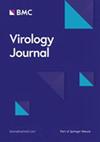利用光学镊子量化登革病毒与多巴胺 2 型受体之间的相互作用力
IF 4
3区 医学
Q2 VIROLOGY
引用次数: 0
摘要
登革热病毒(DENV)是由蚊子传播的最主要的病毒性疾病,临床表现广泛,包括与致命性登革热疾病相关的神经系统症状。多巴胺受体在中枢神经系统中表达,据报道,多巴胺拮抗剂在体内和体外对登革热病毒感染具有抗病毒活性。虽然宿主细胞受体的鉴定对于了解登革热神经发病机制和神经趋向性至关重要,但多巴胺受体参与登革热病毒感染的情况仍不清楚。我们利用力谱仪的灵敏性和精确性来研究多巴胺2型受体(D2R)是否在感染的第一步就直接与DENV颗粒相互作用。利用光学镊子,我们对DENV与表达在中国仓鼠卵巢(CHO)细胞上的D2R的结合进行了定量和定性。我们的发现表明,这种结合是D2R和DENV依赖性的,结合力在50-60 pN之间。我们发现多巴胺拮抗剂丙氯丙嗪(PCZ)和三氟拉嗪(TFP)(以前曾报道可抑制登革热感染)可中断DENV-D2R特异性结合。本研究表明,D2R能特异性识别DENV颗粒,并作为DENV在细胞表面的附着因子发挥作用。我们认为 D2R 是 DENV 的宿主受体,也是抗 DENV 药物的潜在治疗靶点。本文章由计算机程序翻译,如有差异,请以英文原文为准。
Quantification of the interaction forces between dengue virus and dopamine type-2 receptor using optical tweezers
Dengue virus (DENV) causes the most significant mosquito-borne viral disease with a wide spectrum of clinical manifestation, including neurological symptoms associated with lethal dengue diseases. Dopamine receptors are expressed in central nervous system, and dopamine antagonists have been reported to exhibit antiviral activity against DENV infection in vivo and in vitro. Although identification of host-cell receptor is critical to understand dengue neuropathogenesis and neurotropism, the involvement of dopamine receptors in DENV infection remains unclear. We exploited the sensitivity and precision of force spectroscopy to address whether dopamine type-2 receptors (D2R) directly interact with DENV particles at the first step of infection. Using optical tweezers, we quantified and characterized DENV binding to D2R expressed on Chinese hamster ovary (CHO) cells. Our finding suggested that the binding was D2R- and DENV-dependent, and that the binding force was in the range of 50–60 pN. We showed that dopamine antagonists prochlorperazine (PCZ) and trifluoperazine (TFP), previously reported to inhibit dengue infection, interrupt the DENV-D2R specific binding. This study demonstrates that D2R could specifically recognize DENV particles and function as an attachment factor on cell surfaces for DENV. We propose D2R as a host receptor for DENV and as a potential therapeutic target for anti-DENV drugs.
求助全文
通过发布文献求助,成功后即可免费获取论文全文。
去求助
来源期刊

Virology Journal
医学-病毒学
CiteScore
7.40
自引率
2.10%
发文量
186
审稿时长
1 months
期刊介绍:
Virology Journal is an open access, peer reviewed journal that considers articles on all aspects of virology, including research on the viruses of animals, plants and microbes. The journal welcomes basic research as well as pre-clinical and clinical studies of novel diagnostic tools, vaccines and anti-viral therapies.
The Editorial policy of Virology Journal is to publish all research which is assessed by peer reviewers to be a coherent and sound addition to the scientific literature, and puts less emphasis on interest levels or perceived impact.
 求助内容:
求助内容: 应助结果提醒方式:
应助结果提醒方式:


